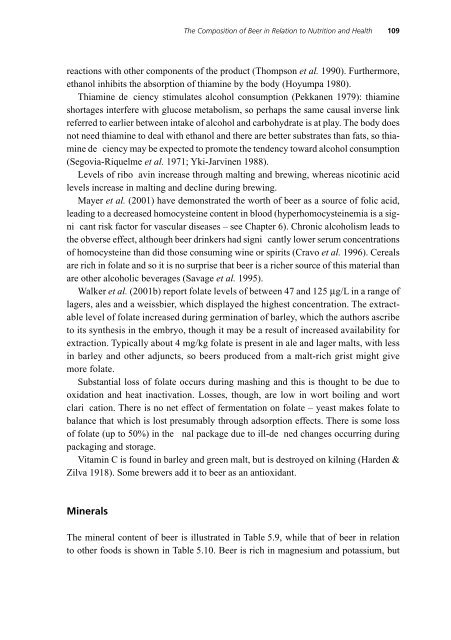Beer : Health and Nutrition
Beer : Health and Nutrition
Beer : Health and Nutrition
Create successful ePaper yourself
Turn your PDF publications into a flip-book with our unique Google optimized e-Paper software.
The Composition of <strong>Beer</strong> in Relation to <strong>Nutrition</strong> <strong>and</strong> <strong>Health</strong> 109<br />
reactions with other components of the product (Thompson et al. 1990). Furthermore,<br />
ethanol inhibits the absorption of thiamine by the body (Hoyumpa 1980).<br />
Thiamine de ciency stimulates alcohol consumption (Pekkanen 1979): thiamine<br />
shortages interfere with glucose metabolism, so perhaps the same causal inverse link<br />
referred to earlier between intake of alcohol <strong>and</strong> carbohydrate is at play. The body does<br />
not need thiamine to deal with ethanol <strong>and</strong> there are better substrates than fats, so thiamine<br />
de ciency may be expected to promote the tendency toward alcohol consumption<br />
(Segovia-Riquelme et al. 1971; Yki-Jarvinen 1988).<br />
Levels of ribo avin increase through malting <strong>and</strong> brewing, whereas nicotinic acid<br />
levels increase in malting <strong>and</strong> decline during brewing.<br />
Mayer et al. (2001) have demonstrated the worth of beer as a source of folic acid,<br />
leading to a decreased homocysteine content in blood (hyperhomocysteinemia is a signi<br />
cant risk factor for vascular diseases – see Chapter 6). Chronic alcoholism leads to<br />
the obverse effect, although beer drinkers had signi cantly lower serum concentrations<br />
of homocysteine than did those consuming wine or spirits (Cravo et al. 1996). Cereals<br />
are rich in folate <strong>and</strong> so it is no surprise that beer is a richer source of this material than<br />
are other alcoholic beverages (Savage et al. 1995).<br />
Walker et al. (2001b) report folate levels of between 47 <strong>and</strong> 125 µg/L in a range of<br />
lagers, ales <strong>and</strong> a weissbier, which displayed the highest concentration. The extractable<br />
level of folate increased during germination of barley, which the authors ascribe<br />
to its synthesis in the embryo, though it may be a result of increased availability for<br />
extraction. Typically about 4 mg/kg folate is present in ale <strong>and</strong> lager malts, with less<br />
in barley <strong>and</strong> other adjuncts, so beers produced from a malt-rich grist might give<br />
more folate.<br />
Substantial loss of folate occurs during mashing <strong>and</strong> this is thought to be due to<br />
oxidation <strong>and</strong> heat inactivation. Losses, though, are low in wort boiling <strong>and</strong> wort<br />
clari cation. There is no net effect of fermentation on folate – yeast makes folate to<br />
balance that which is lost presumably through adsorption effects. There is some loss<br />
of folate (up to 50%) in the nal package due to ill-de ned changes occurring during<br />
packaging <strong>and</strong> storage.<br />
Vitamin C is found in barley <strong>and</strong> green malt, but is destroyed on kilning (Harden &<br />
Zilva 1918). Some brewers add it to beer as an antioxidant.<br />
Minerals<br />
The mineral content of beer is illustrated in Table 5.9, while that of beer in relation<br />
to other foods is shown in Table 5.10. <strong>Beer</strong> is rich in magnesium <strong>and</strong> potassium, but

















